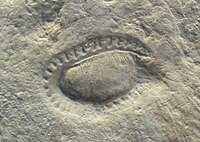Avalon explosion




The Avalon explosion, named from the Precambrian faunal trace fossils discovered on the Avalon Peninsula in Newfoundland, eastern Canada, is a proposed evolutionary radiation of prehistoric animals about 575 million years ago in the Ediacaran period, with the Avalon explosion being one of three eras grouped in this time period.[3] This evolutionary event is believed to have occurred some 33 million years earlier than the Cambrian explosion, which had been long thought to be when complex life started on Earth.
Scientists are still unsure of the full extent behind the development of the Avalon explosion,[3] which resulted in a rapid increase in metazoan biodiversity, including the first appearance of some extant infrakingdoms/superphyla such as cnidarians and bilaterians. Many of the Avalon explosion animals are sessile soft-bodied organisms living in deep marine environments,[4] and the first stages of the Avalon explosion were observed through comparatively minimal species.[3]
History
Charles Darwin predicted a time of ecological growth before the Cambrian Period, but there was no evidence to support it until the Avalon explosion was proposed in 2008 by Virginia Tech paleontologists after analysis of the morphological space change in several Ediacaran assemblages.[3][4] The discovery suggests that the early evolution of animals may have involved more than one explosive event.[5] The original analysis has been the subject of dispute in the literature.[6][7][8]
Evidence
Trace fossils of these Avalon organisms have been found worldwide, with many found in Newfoundland, in Canada and the Charnwood Forest in England,[3] representing the earliest known complex multicellular organisms.[a] The Avalon explosion theoretically produced the Ediacaran biota.[4][3] The biota largely disappeared contemporaneously with the rapid increase in biodiversity known as the Cambrian explosion. At this time, all living animal groups were present in the Cambrian oceans.[3]
The Avalon explosion appears similar to the Cambrian explosion in the rapid increase in diversity of morphologies in a relatively small-time frame, followed by diversification within the established body plans,[3][9] a pattern similar to that observed in other evolutionary events.[9]
Plants and animals
The Avalon explosion was a time of early evolution and low diversity in species. There were over 270 species defined,[10] with 50 different morphological characteristics categories, many of whose anatomical structures had to be inferred with fossils and casts.[4][10] These species were placed into 20 different genera.[10]
During this time, animals became bilateral and along with increasing complexity.[11] Many animals during this time fit into the annelid, arthropod, echinoderm, and cnidarian phyla.[11] Animals at this time developed bilateral symmetry with a clear anterior and posterior side, which included species like Spriggina, Charniodiscus and Yorgia.[10]
Many of the plants fit into a now-extinct phylum of Vendobionta.[11] The Vendobionta were arranged several ways - some radial, some parallel, some concentric.[12] Frondlets were a prominent aquatic plant during this time, with many different shapes, including Fractofusus which is a spindle shape, Fradgatia, a lettuce shape, and Rangea which was a leaf shape.[11]
See also
- Cambrian explosion
- Carboniferous-Earliest Permian Biodiversification Event
- Great Ordovician Biodiversification Event
Notes
References
- ^ Porter, S.M. (1 June 2007). "Seawater Chemistry and Early Carbonate Biomineralization". Science. 316 (5829): 1302. Bibcode:2007Sci...316.1302P. doi:10.1126/science.1137284. PMID 17540895. S2CID 27418253.
- ^ Wade, M. (1972). "Hydrozoa and Scyphozoa and other medusoids from the Precambrian Ediacara fauna, South Australia" (PDF). Palaeontology. 15: 197–225. Archived from the original (PDF) on 9 April 2011.
- ^ a b c d e f g h Shen, Bing; Dong, Lin; Xiao, Shuhai; Kowalewski, Michał (4 January 2008). "The Avalon Explosion: Evolution of Ediacara Morphospace". Science. 319 (5859): 81–84. Bibcode:2008Sci...319...81S. doi:10.1126/science.1150279. ISSN 0036-8075. PMID 18174439. S2CID 206509488.
- ^ a b c d "Two Explosive Evolutionary Events Shaped Early History Of Multicellular Life" (Press release). Virginia Tech. January 4, 2008. Retrieved 2018-03-06 – via ScienceDaily.
- ^ "The Avalon Explosion". Astrobiology Magazine. 8 January 2008. Archived from the original on 2 August 2012. Retrieved 14 June 2012.
- ^ Freeman, Gary (2009). "The rise of bilaterians". Historical Biology. 21 (1–2): 99–114. Bibcode:2009HBio...21...99F. doi:10.1080/08912960903295843. S2CID 83841216.
- ^ Xiao, Shuhai; Kowalewski, Michał; Shen, Bing; Dong, Lin; Laflamme, Marc (8 January 2010). "The rise of bilaterians: a reply". Historical Biology. 21 (3–4): 239–246. doi:10.1080/08912960903471659. S2CID 84488359.
- ^ Freeman, Gary (30 June 2010). "Comment on Xiao et al. (2009), response to: the rise of bilaterians". Historical Biology. 22 (4): 430–432. Bibcode:2010HBio...22..430F. doi:10.1080/08912960903562259. S2CID 85339496.
- ^ a b Xiao, Shuhai; Laflamme, Marc (January 2009). "On the eve of animal radiation: phylogeny, ecology and evolution of the Ediacara biota". Trends in Ecology & Evolution. 24 (1): 31–40. Bibcode:2009TEcoE..24...31X. doi:10.1016/j.tree.2008.07.015. PMID 18952316.
- ^ a b c d Shen, Bing; Dong, Lin; Xiao, Shuhai; Kowalewski, Michał (4 January 2008). "The Avalon Explosion: Evolution of Ediacara Morphospace". Science. 319 (5859): 81–84. Bibcode:2008Sci...319...81S. doi:10.1126/science.1150279. ISSN 0036-8075. PMID 18174439. S2CID 206509488.
- ^ a b c d Xiao, Shuhai; Laflamme, Marc (January 2009). "On the eve of animal radiation: phylogeny, ecology and evolution of the Ediacara biota". Trends in Ecology & Evolution. 24 (1): 31–40. Bibcode:2009TEcoE..24...31X. doi:10.1016/j.tree.2008.07.015. ISSN 0169-5347. PMID 18952316.
- ^ Peterson1, Kevin J.; Waggoner, Ben; Hagadorn, James W. (February 2003). "A fungal analog for Newfoundland Ediacaran fossils?". Integrative and Comparative Biology. 43 (1): 127–136. doi:10.1093/icb/43.1.127. PMID 21680417.
{{cite journal}}: CS1 maint: numeric names: authors list (link)
